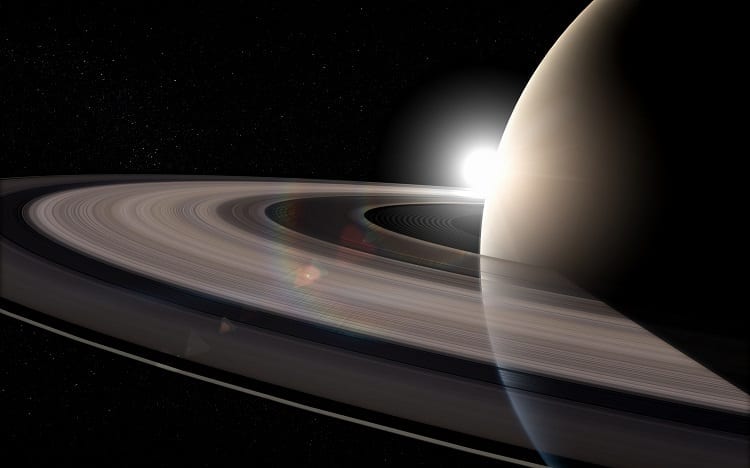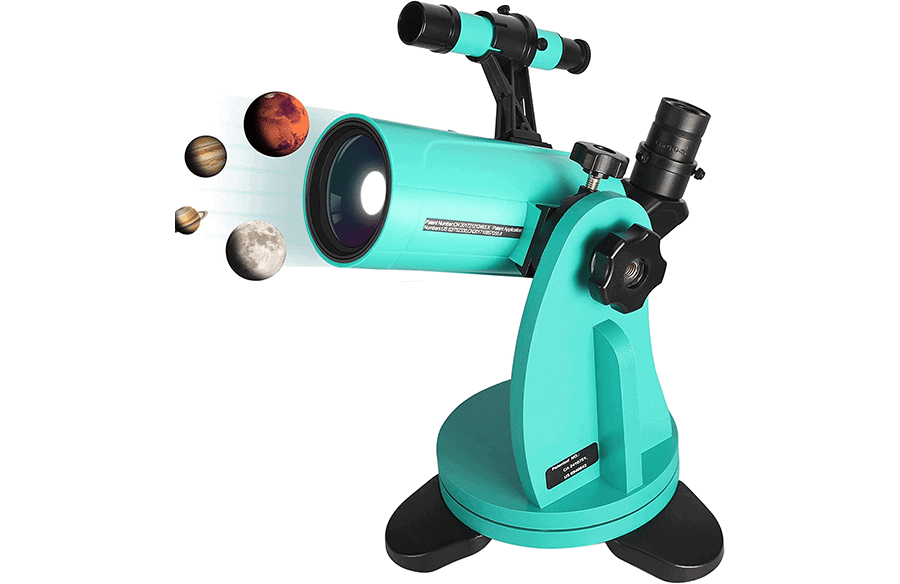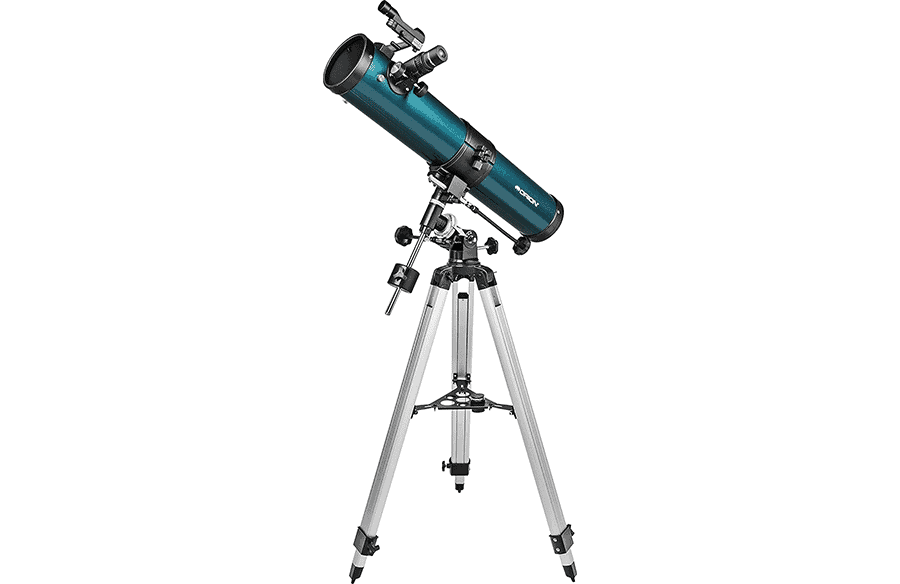While telescope prices have increased and selections have become more limited due to supply chain issues, it’s still possible to get a pretty good beginner telescope for under $200, even off Amazon. If you’re looking for something more capable than the below options, a larger Dobsonian telescope might be a good idea; we have guides for budgets of $500 and $1000 as well with a variety of different options. If your budget is below $100, you might want to consider a pair of well-made binoculars instead, as no good telescopes exist in this price range.
FEATURES: f/4 focal ratio, 400mm focal length, and two Kellner eyepieces (17mm and 10mm)
BENEFITS
- Adequate 100mm aperture
- Sturdy, easy-to-use Dobsonian mount
- Quality included accessories
- Well-designed red dot finder
FEATURES: 750mm focal length, and 20mm Kellner eyepiece with 38x magnification
BENEFITS
- Sharp Maksutov-Cassegrain optics provide great views of the Moon and planets
- Extremely portable
- Easy to demonstrate due to removable side of tube
- Acceptable included accessories
FEATURES: f/4.4 aperture, 500mm focal length, and two Plossls eyepieces (114mm - 25mm and 10mm)
BENEFITS
- Large 114mm aperture
- Sturdy equatorial mount
- Quality included eyepieces
- Fairly lightweight
FEATURES: f/9 focal ratio, 700mm focal length, and two Kellner eyepieces (10mm and 25mm)
BENEFITS
- Easier to collimate thanks to long focal ratio
- 76mm aperture enough for some deep-sky viewing
- Well-made included accessories
- Lightweight but sturdy mount/tripod
FEATURES: f/5 focal ratio, 400 mm focal length, and two eyepieces (20mm and 10mm)
BENEFITS
- Refractor design is simple and low-maintenance
- Great included eyepieces
- Designed with portability in mind
- Plenty of light-gathering ability
The telescopes on this list have been carefully selected to avoid shoddy optics, all-plastic eyepieces, wobbly mounts and other such detrimental aspects which can make for a œhobby-killer telescope which is frustrating or completely impossible to use. At this price point, you are looking at rather small aperture instruments, but even a 60mm telescope provides great views of the Moon and planets, and a 100mm or greater telescope provides great deep-sky views under suburban or dark skies. The biggest compromise made with cheaper telescopes tends to be in what eyepieces are included; thankfully eyepieces are universal in size and fitting, and fairly easy to find for low prices.
Contents
Zhumell Z100
The Zhumell Z100 provides a wide field of view, has enough aperture to show you stuff, and it’s simple Dobsonian mounting makes it easy to navigate around the night sky. The Z100 includes a pair of high-quality Kellner eyepieces (17mm and 10mm providing 24x and 40x respectively) which are great to start off with, and its red dot finder is well-made and easy to use for aiming the telescope.
You can use the Z100 on a tabletop, the hood of your car, or even a sturdy photo tripod thanks to the threads on the bottom of the base. It’s lightweight enough to carry out in one hand and be using in seconds, and can even fit in a backpack or luggage if need be.
The Z100 is mostly designed for looking at œfaint fuzzies like galaxies and nebulae, but performs great on the Moon and planets too. However, it does need a specialty additional eyepiece in order to achieve suitable magnifications for viewing the planets, and collimating the telescope – that is, aligning the mirrors for the sharpest possible images – is somewhat difficult to do yourself due to the lack of built-in adjustments.
The SarBlue Mak60 is an utterly tiny telescope with a tube barely bigger than a beverage can. It weighs practically nothing, and fits in pretty much any kind of container. The Mak60 is offered with a photo tripod and metal tabletop tripod, but the Dobsonian mounting option is the best of the 3 supplied kits and provides steady views free of vibrations or jerky controls. It’s great for viewing the Moon and planets; the included 20mm Kellner eyepiece provides 38x magnification, while additional, aftermarket third-party eyepieces can provide varying magnification powers up to about 120x or so.
The Mak60’s tiny aperture means it’s not the best for viewing deep-sky objects outside of the Solar System. It’s best accompanied by a pair of 50-60mm aperture binoculars which can be purchased cheaply and used handheld, providing superior deep-sky views to the Mak60 but lacking its magnification abilities for smaller targets like tiny lunar craterlets, the rings of Saturn, the phases of Venus, the polar ice caps on Mars, or the various cloud belts on Jupiter.
The Observer 114mm provides a bit more aperture than some of the other scopes on our list, along with a full-sized equatorial mount and tripod. It can show you plenty of star clusters, nebulae, and even galaxies provided you can get away from city light pollution. It also has no trouble resolving the moons of Jupiter as tiny disks or revealing the Cassini Division in Saturn’s rings, whereas a smaller scope might struggle.
The eyepieces included with the Observer 114mm – 25mm and 10mm Plossls providing 20x and 50x respectively – aren’t bad, and the optics are well-made and completely adjustable for collimation. However, the equatorial mount is somewhat cumbersome and confusing for beginners, while the scope’s attached red dot finder is poorly designed and hard to keep aligned and consistently powered on when in use. You can get an Observer 114mm kit with a 2x Barlow lens (allowing for magnifications of 40x and 100x with the included eyepieces) which might be a good idea, or upgrade to the larger 134mm model as well.
The SpaceProbe II doesn’t have as much aperture as the other reflectors on our list, but its long focal ratio of f/9 makes it a little easier on cheaper eyepieces compared to the larger f/4 scopes which can have less-than-sharp stars towards the outer area of a low-power view with the included kit eyepieces. It also means that the included 10mm Kellner eyepiece provides an optimally high magnification of 70x, great for viewing details of the planets or splitting double stars with no additional purchase needed right away. The included 25mm Kellner ocular provides a magnification of 28x – a little more cramped than other scopes on this list, but plenty wide of a view for looking at nebulae and star clusters. The SpaceProbe II’s equatorial mount is also lightweight and sturdy with such a small instrument mounted atop it.
An optional kit provided by Orion, which we heartily recommend, adds in a few star charts, a red flashlight for finding your accessories in the dark without ruining your night vision, and most importantly a 2x 1.25 Barlow lens, allowing you to double the magnifications of the included eyepieces to 56x and 140x – making for a great medium magnification solution while allowing you to push the limit of what the 3 aperture of the SpaceProbe can resolve at 140x.
The TravelScope 80 certainly isn’t perfect, but you get a lot for your money. The refractor design of the TravelScope 80 means you need not worry about collimating the telescope, and its lack of obstructions or multiple optical surfaces means it ends up having similar light-gathering power to a 100mm or even 114mm reflector like the ones on our list. The included 1.25 eyepieces (20mm and 10mm Konigs providing 20x and 40x respectively) are sharp, well-made, offer a wide field of view and are comfortable to look through too. The scope comes with a carry bag and is extremely lightweight, able to be picked up with one hand easily.
Drawbacks? For one thing, the TravelScope 80’s performance on planets is poor thanks to the chromatic aberration or false color that permeates bright targets, turning sharp stars and planets into mushy blobs with purple halos. The included 45-degree prism is not meant for astronomy and makes aiming the scope high in the sky uncomfortable – but fortunately a right-angle star diagonal is cheap. The 5×24 finderscope is poorly made, but you hardly need it at all. The biggest issue is the cheap photo tripod supplied, which can make aiming a little difficult – fortunately, the TravelScope 80 is designed to be used at low magnifications where these issues are less prevalent or obvious.
Comparison Table
Telescopes for Under $200 FAQ
So far, this article has featured five of the best telescopes you can buy for under $200, but there are some important things you need to consider when choosing a telescope.
Picking the right telescope type for your needs
https://www.youtube.com/watch?v=1BiytApIbesu0026ab_channel=WoodlandHillsCamera%26Telescopes
When you choose a telescope, you have to ensure that it will allow you to see as much as possible in the night sky. You don’t want to spend money on it only to find that it limits your astronomy hobby. So, with that in mind, let’s look at some of the most important features to consider before you purchase a telescope.
- Aperture. Without a good aperture, you won’t be able to collect enough light to see the objects in the sky. The aperture is basically the diameter of the telescope’s lens or mirror. It should be at least 70mm.
- Type. You will have to choose between a reflector and refractor telescope. It’s not always easy to know which one is better, so it comes down to your needs. If you want to see the moon and planets, choose a refractor. On the other hand, if you want to see deep-sky celestial objects, like galaxies, you should choose the reflector telescope.
- Mount. Now, even the most expensive telescope in the world won’t be good enough if it’s not set on a sturdy mount to prevent image distortions. There are two mounts to choose from: equatorial mounts and altazimuth mounts. Both have their advantages, but consider this:
- An altazimuth mount has a pan-and-tilt head that moves the telescope up and down and left and right. Equatorial mounts, on the other hand, are tilted so that they can be aligned with the earth’s rotational axis.
- If you want to use your mount for light sightseeing of the sky, an altazimuth mount will meet your needs. On the other hand, an equatorial mount will be much more powerful if you want to track celestial objects and you have a deep interest in astronomy.
- Convenience. This is not just something that will appeal to beginners. You want a telescope that won’t make you sweat when you set it up! It has to be user-friendly. You also want a telescope that you can grab-and-go whenever you want to head out to a remote stargazing location. So, it should be compact and easy to carry.
What telescopes are best for deep-space viewing?
https://www.youtube.com/watch?v=-R091GDLbC4u0026ab_channel=VeryInterestingChannel
If you intend on searching for and viewing deep-space objects, such as nebulae and galaxies, you’ll need to ensure that your telescope is up to the task at hand! Here are some important things to look for.
- Aperture. As with our previous tips on how to choose a telescope, its aperture is one of the most important features to look for. Some galaxies and nebulae in deep space will be very dim, so you want a telescope that’s capable of collecting as much light as it can in order to bring them into view.
- Equatorial mount. A telescope that has an equatorial mount is definitely worth purchasing if you’re interested in deep-sky objects. This is because the telescope will move in many directions, not just up and down or side to side. As the Earth moves, the telescope will be able to track celestial objects.
- Magnification. Contrary to popular belief, you don’t need a very high magnification to be able to see deep-sky objects such as galaxies. You need to ensure that you have 35x to 50x on a four-inch scope, 70x to 100x on an eight-inch scope, and 120x to 175x on a 14-inch scope (via Starizona).
- Short focal length. While a longer focal length is sometimes said to be a good thing because of how it provides a narrow field of view but makes objects seem larger, a shorter focal length is beneficial for deep-sky objects like star clusters because it provides you with a larger field of view. However, the celestial objects will seem smaller.
- Refractors. Since they contain specialized lenses, refractor telescopes are ideal for deep-sky views.
What celestial bodies can I expect to see with telescopes under $200?

The good news about buying a budget-friendly telescope that doesn’t cost more than $200 is that it will have many features that you’d find in high-end devices.
Based on our review of the best telescope for beginners under $200, we can see that the best telescopes on the market offer decent apertures that allow you to see various celestial objects.
An example is the Celestron PowerSeeker 127EQ Telescope, which comes with an Equatorial mount and can help you see planets as well as their details, such as Saturn’s rings.
Other telescopes, such as the Orion StarBlast II 4.5 Equatorial Reflector Telescope, will provide you with the chance to view star clusters and nebulae.
It’s been said (via New Atlas) that telescopes which are considered to be for beginners will have an objective diameter (or aperture) of about 60 to 115mm, but this is enough for you to see a variety of objects, such as the moon, planets, galaxies such as the Andromeda, and more.
As a sidebar, the Orion StarBlast II 4.5 Equatorial Reflector Telescope that we featured in our reviews of the best telescopes has a 114mm aperture, so that will provide you with more than enough light to view all the treasures listed above.
So, it’s clear that you will be able to see many celestial bodies with a telescope that doesn’t cost a lot of money.
Can telescopes under $200 do astrophotography?

If you want to take pictures of space objects, not just look at them, you might be wondering if you can achieve this goal with telescopes that cost less than $200.
To answer that question, let’s look at what features your telescope needs to have for you to do astrophotography.
Your telescope needs to have a mount
This will make tracking the objects you want to photograph much easier. Remember, the Earth rotates, so you want to capture those slow-moving objects!
Some of the best telescopes under $200 have Equatorial mounts to help you with this task, such as Orion StarBlast II 4.5 Equatorial Reflector Telescope that we featured in our reviews.
Your telescope needs a wide enough aperture
We’ve said it once and we’ll say it again: your telescope needs as large an aperture as possible! If it can collect enough light, this will also ensure that you can take detailed photos, especially if you’re hooking up your camera or smartphone to your telescope.
Aim for a telescope with around 114mm, such as the Orion StarBlast II 4.5 Equatorial Reflector Telescope.
Your telescope needs the right focal length
If you want to photograph deep-sky objects, such as galaxies, you’ll need a shorter focal length because it will let you have a larger field of view.
A longer focal length will be better for viewing planets and the moon because it will give you a narrow field of view but allow the objects to be larger so you can look at their fine details. The Orion StarBlast II has a short focal length.
The best telescopes under $200 tick all the right boxes!
Conclusion
You want to purchase a telescope, but you don’t want to spend a lot of money. As we’ve seen in this buying guide of the best telescopes, you really don’t have to spend a lot in order to purchase a quality telescope.
Telescopes are becoming much more accessible to the general public, but it’s important to know which ones are worth your time and energy. Whilst telescopes in this price range are solid picks, we find that beginner astronomers may quickly outgrow them. Consider a telescope under $500 or check out our post on the best refractor telescopes if you’re looking to future proof your kit.
In these reviews we have featured five of the best telescopes you can buy for under $200, along with some important information you need to make the best choice for what you want to use them for, such as if you want to study deep-sky objects or capture Saturn’s rings.






